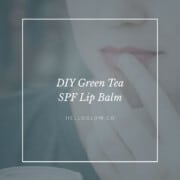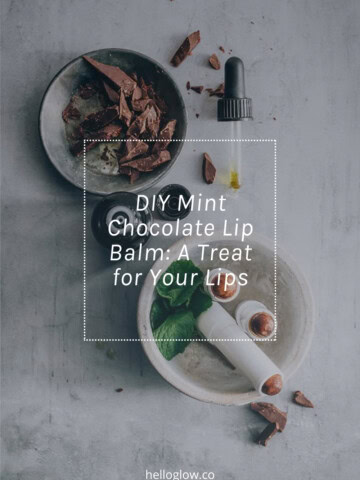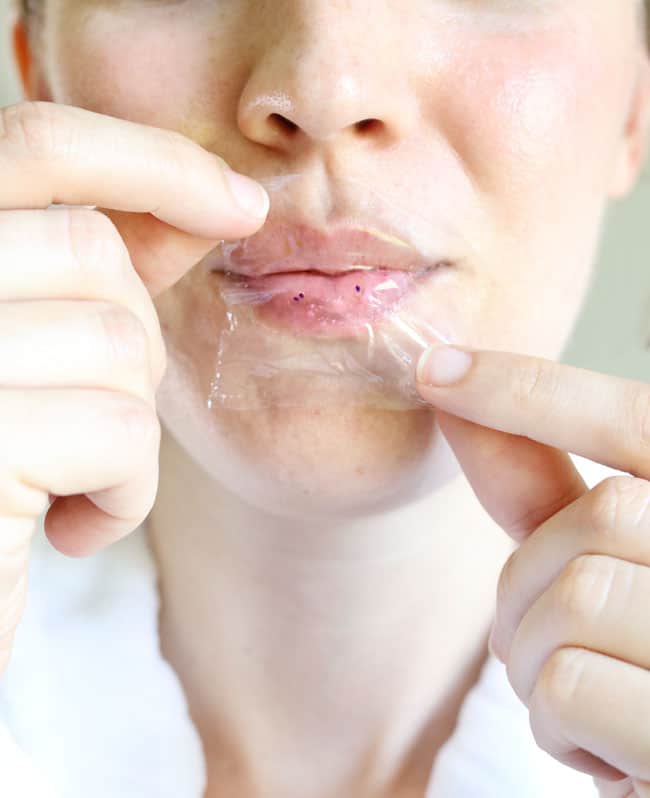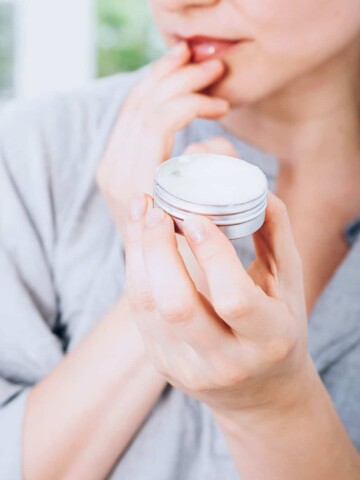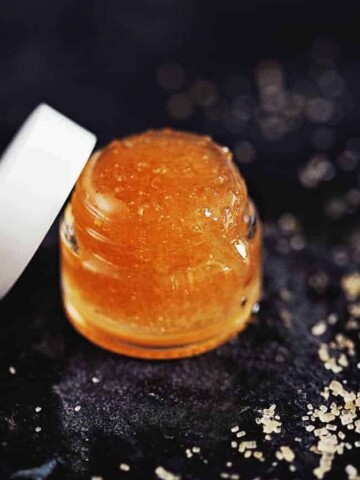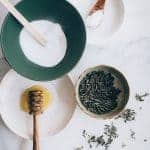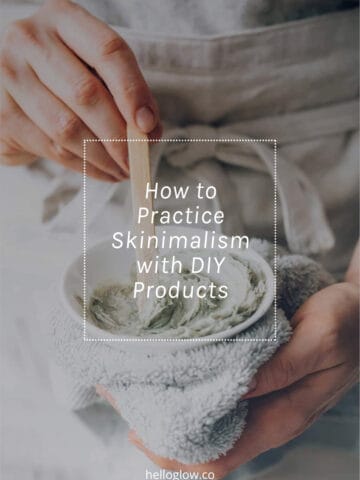This is the hardest working lip balm around and will protect your pout all summer. Learn how to make SPF lip balm that combines green tea, zinc oxide, natural oils, and butters to provide protection from both UVA and UVB rays.

Some folks panic if they don't have their phone. Oh, who am I kidding? That's totally me. But I really get the shakes if I can't find my favorite homemade lip balm. That is a true emergency!
It’s so easy to forget about SPF on our lips, but it’s just as important. Spending too much time in the sun without proper lip protection can lead to dry, chapped lips, and who wants that? This DIY SPF lip balm works great under lip gloss, too.
Jump to:
How to Add SPF to Lip Balm

This spf lip balm recipe using several natural sun protection ingredients:
- 2 ounces green tea-infused oil
- ¼ ounce beeswax
- 1 teaspoon raw honey
- 1 tsp avocado oil
- 2 tsp zinc oxide powder
1. Green tea
The polyphenols contained in green tea can protect the skin against some of the damaging effects of exposure to UV radiation and prevent premature skin aging [source]. Because it is high in antioxidants, particularly the free radical-neutralizing kind, green tea can prevent some of the effects of sun damage, like sun-induced redness and inflammation [source].
Since tea contains caffeine, it has the additional bonus of firming your skin, reducing puffiness around your eyes, and protecting the skin from the aging effects of oxidative stress [source].
Caffeine also boosts the photoprotective activity of any sunscreen you use [source]. And anything protecting your skin from the sun’s ultraviolet rays goes a long way toward the prevention of skin cancer.
2. Zinc oxide
Long used for sun protection (remember those white noses?), zinc oxide is a powdered mineral that sits on top of the skin, scattering, reflecting, and absorbing UVA and UVB rays. To provide the physical barrier on the outer layer of skin, you need to use non-nano, uncoated zinc oxide to avoid it absorbing into the skin.
Try mixing in a tablespoon with a face lotion or homemade lip balm, and you’re ready for the rays. It’s a great hardcore sunblock and perfect for babies or fair skin.
3. Carrier oils like coconut and avocado
Using oil to protect your skin seems counterintuitive at first, but some household plant-based oils contain elements that aid your skin’s sun protection [source]. Of the more common household oils, coconut, almond, and olive oil all share an SPF of 2—7 and block out about 20% of UV rays [source], providing long-lasting performance and hydration.
—Avocado oil: SPF 4–15
—Olive oil: SPF 2–8
—Coconut oil: SPF 4–6
—Almond oil: SPF 5
—Jojoba oil: SPF 4
Since these oils in their different forms have not been tested to the degree that commercial sunscreens have, it is best to use them in combination with those to boost their SPF power and provide additional healing and antiaging effects.
Instructions
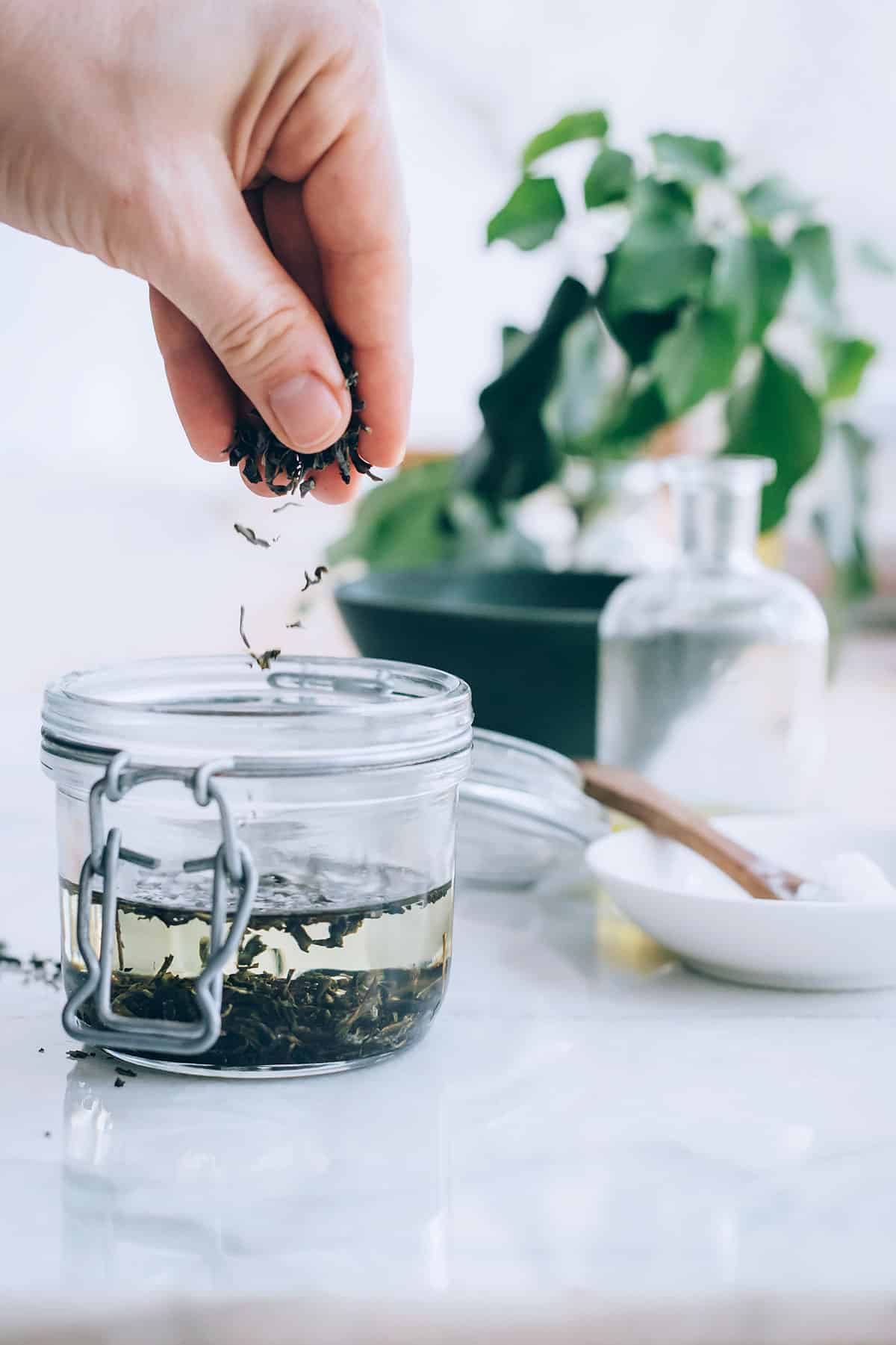
Step 1 | Infuse coconut oil with green tea
Infusing oils is one of my favorite things, and to add SPF to lip balm, green tea is the perfect choice. When applied to the skin, green tea can absorb UV rays.
Now green tea alone won't give you enough sun protection, but it's a great complimentary ingredient because it has antioxidants that also help your skin resist UV damage and the aging effects that come with it. Green tea oil also makes my favorite face moisturizer.
Because it’s so cleansing and non-greasy, you can just dab an extra-strong brew on with a cotton ball like you would an astringent or make this cooling body spray. Try adding a glass of iced green tea in the afternoon for a booster: green tea works from the inside out, too!
Step 2 | Melt beeswax
Combine the oil and beeswax in a double boiler over medium heat and heat until the beeswax has melted.
Step 3 | Add oil + honey
Remove from the heat and stir in honey and avocado oil. Avocado oil has antioxidant, anti-aging effects that combat sun damage and, like all of the plant oils, helps skin to repair itself [source].
I tend to get eczema breakouts on my arms during the summer, and avocado oil, with its natural SPF of 4–15, knocks it right off in a day or two.
Step 4 | Add zinc oxide
Use non-nano zinc oxide to avoid the risk of it being absorbed into the skin and wear a mask during this step to avoid inhaling the fine particles.
Aim for around 20% of the total weight of your lotion for SPF 30, but exact measurements can vary. I used 2 teaspoon zinc oxide powder, but how much zinc oxide to add to lip balm is up to you.
Stir the mixture vigorously to ensure that the zinc oxide is evenly dispersed with no clumps. Work fast because zinc oxide will thicken up your mixture quickly!
Step 4 | Whip together
Blend with an electric handheld mixer until creamy. More info on whipping oils here.
How to Use SPF Lip Balm
The zinc oxide lip balm recipe leaves a slight white tint on your lips, which acts as a physical barrier SPF that goes away as it melts into the skin. Not into the white tint? Mix in a bit of bronzing powder.
Apply this balm, layer a pretty gloss on top, and you're good to go. Reapply as needed throughout the day.
More Homemade Sunscreen Recipes
Store-bought sunscreens often contain harsh chemicals that many experts believe can lead to health issues. Oxybenzone and octinoxate are two of the most common ingredients in sunscreens, and many now believe these can mess with our hormones and endocrine system [source].
It's important to note that homemade products have not been tested for actual SPF value, and their effectiveness can vary. For reliable sun protection, especially during prolonged exposure, stick with one of our favorite sunscreens.
1. Whipped DIY Sunscreen with Red Raspberry Seed Oil
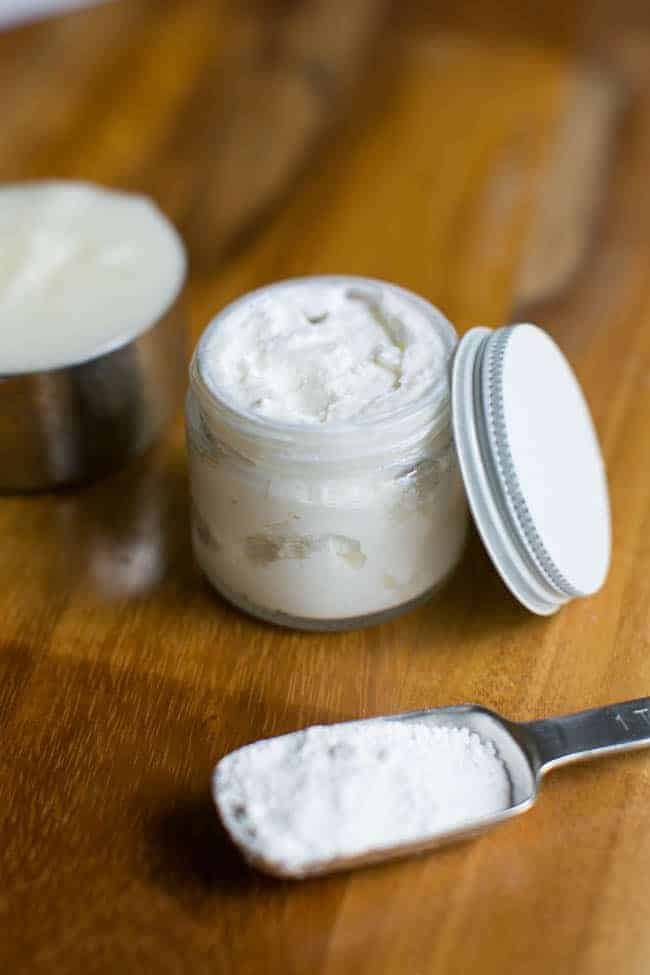
For more natural sun protection, try red raspberry seed oil. According to a paper published in 2000, it appears that raspberry seed oil naturally has an SPF of about 28–50 for blocking UV-B waves (which are the wavelengths of ultraviolet light that cause more damage to skin cells), and a factor of between 6.75 and 7.5 sun protection for UV-A [source].
The article goes on to state that this oil could “act as a broad-spectrum UV protectant.” This is because the vitamins A, C, and vitamin E it contains work as potent antioxidants [source] to protect against harmful UV rays.
The main advantage of these plant-based compounds, however, is the protection by carotenoids, flavonoids, polyphenols, and many other natural compounds that work as antioxidants and anti-inflammatories to mitigate damage caused by the sun’s harmful rays [source].
In particular, red raspberry extract has been shown to prevent cell death caused by UV-B rays and protects against skin injury “manifested by wrinkling, scaling, tanning, and water loss as well as epidermal thickening [source].”
Ingredients
- ¼ cup coconut oil (this giant jar will last forever)
- ¼ cup shea butter
- 1 tsp red raspberry seed oil
- 2 tbsp zinc oxide (make sure it's non-nano)
Instructions
1. Melt coconut oil and shea butter in a bowl over warm water.
2. Add red raspberry seed oil and zinc oxide and stir together.
3. Cool in the refrigerator for 30 minutes–1 hour until you get a solid consistency. Whip for 3–5 minutes until you get a frosting-like consistency.
4. Transfer to a container with a lid and store in a cool place. Apply liberally. And always wear a hat and glasses!
Like the other oils already mentioned, it’s best to use red raspberry seed oil in combination with conventional sunscreen to provide additional protection and healing power.
2. Shea Sunscreen Booster

Shea butter also naturally protects and conditions damaged skin and offers a low level of UV protection (approximately SPF 6).
To DIY your own natural sunscreen booster, mix equal parts of your chosen natural oil (organic if possible) with shea butter and beeswax in a pan over low heat.
Stir the shea balm until it’s thoroughly blended, pour the mixture into a container, and let it cool. Once it’s hardened at room temperature, you’re ready to go!
Since carrier oils and shea butter have low SPF numbers they aren’t appropriate to substitute for sunscreen—try them instead as a moisturizing after-shower oil for an added protective boost, particularly under light summer clothing. Primarily, they help moisturize skin and repair skin damage.
3. Zinc SPF Lotion

You can make a super simple SPF lotion by combining 1 tablespoon zinc oxide with 2 ounces of body lotion.
I am just a little too vain to rock the mime look, though—I mix in loose foundation or bronzing powder for a bronzing lotion to make it less noticeable.
FAQ
Making your own lip balm allows you to control the ingredients and tailor it to your preferences. It's also a really fun activity for the whole family!
Green tea is rich in antioxidants, which can help protect the delicate skin on your lips from environmental stressors. It also has anti-inflammatory properties that can help soothe and calm irritated lips.
To make a green tea lip balm, you'll need ingredients like beeswax, coconut oil, shea butter, green tea leaves, and vitamin E oil. Melt the beeswax, coconut oil, and shea butter together, then add the green tea leaves and vitamin E oil. Pour the mixture into lip balm tubes or containers and let it cool and solidify.
You can add a drop or two of flavoring oil to your green tea lip balms for a delicious and personalized scent.
You can use lip balm as often as you feel the need to moisturize your lips. Some people use it once a day, while others may need to apply it multiple times. Even the hardest working lip balm will need to be reapplied after eating and drinking.
More Lip Care Recipes
Want even more natural lip care recipes to try at home? Here are some faves:
DIY Green Tea SPF Lip Balm Recipe
Equipment
- Double boiler
- Small tins or empty lip balm tubes
Materials
For infused oil
- 1 cup coconut oil
- 4 tablespoons loose green tea
For lip balm
- 2 ounces green tea infused oil
- ¼ ounce beeswax
- 1 teaspoon honey
- 1 teaspoon avocado oil
- 2 teaspoons zinc oxide powder
For sunscreen balm
- 1 cup green tea infused coconut oil
- ¼ cup beeswax
- 2 tablespoons red raspberry seed oil
- 1 ounce shea butter
- 2 tablespoons non-nano uncoated zinc oxide
- 1 teaspoon vitamin E oil
- 20 drops carrot seed oil
Instructions
For green tea-infused oil:
- Use a double boiler on medium heat to melt the coconut oil. Stir in the green tea.
- Cover and simmer on lowest heat setting for 1 hour. Strain tea leaves from the oil with cheesecloth.
For lip balm:
- Combine the oil and beeswax in a double boiler over medium heat and heat until the beeswax has melted.
- Remove from the heat and stir in honey, avocado oil, and 2 teaspoons of zinc oxide powder.
- Blend with an electric handheld mixer until creamy.
- Transfer to a container with a lid.
For sunscreen balm:
- Combine the coconut oil, beeswax, and shea butter in a double boiler.
- Heat over low heat until melted. Remove from the heat and let the mixture cool for 1–2 minutes.
- Add the remaining ingredients and stir. The zinc oxide thickens the mixture quite a bit, so add that ingredient last.
- Transfer to a jar and let it cool completely. Replace the lid and keep your balm in a cool, dry place.
Notes
References
References
1. Yusuf N, et al. Photoprotective effect of green tea polyphenols. Photodermatol Photoimmunol Photomed. 2007.
2. OyetakinWhite P, et al. Protective mechanisms of green tea polyphenols in skin. Oxid Med Cell Longev. 2012.
3. Li YF, et al. Caffeine protects skin from oxidative stress-induced senescence through the activation of autophagy. Theranostics. 2018.
4. Rosado C, et al. Another reason for using caffeine in dermocosmetics: sunscreen adjuvant. Front Physiol. 2019.
5. Kaur CD, et al. In vitro sun protection factor determination of herbal oils used in cosmetics. Pharmacognosy Res. 2010.
6. Korać RR, et al. Potential of herbs in skin protection from ultraviolet radiation. Pharmacogn Rev. 2011.
7. Dreher ML, et al. Hass avocado composition and potential health effects. Crit Rev Food Sci Nutr. 2013.
8. Oomah BD, et al. Characteristics of raspberry (Rubus idaeus L.) seed oil. Food Chem. 2000.
9. Darr D, et al. Effectiveness of antioxidants (vitamin C and E) with and without sunscreens as topical photoprotectants. Acta Derm Venereol. 1996.
10. Saewan N, et al. Natural products as photoprotection. J Cosmet Dermatol. 2015.
11. Want PW, et al. Red raspberry extract protects the skin against UVB-induced damage with antioxidative and anti-inflammatory properties. Oxid Med Cell Longev. 2019.
This post was medically reviewed by Dr. Jennifer Haley, a board-certified dermatologist with extensive experience in medical, cosmetic, and surgical dermatology. Learn more about Hello Glow’s medical reviewers here. As always, this is not personal medical advice, and we recommend that you talk with your doctor.
104
